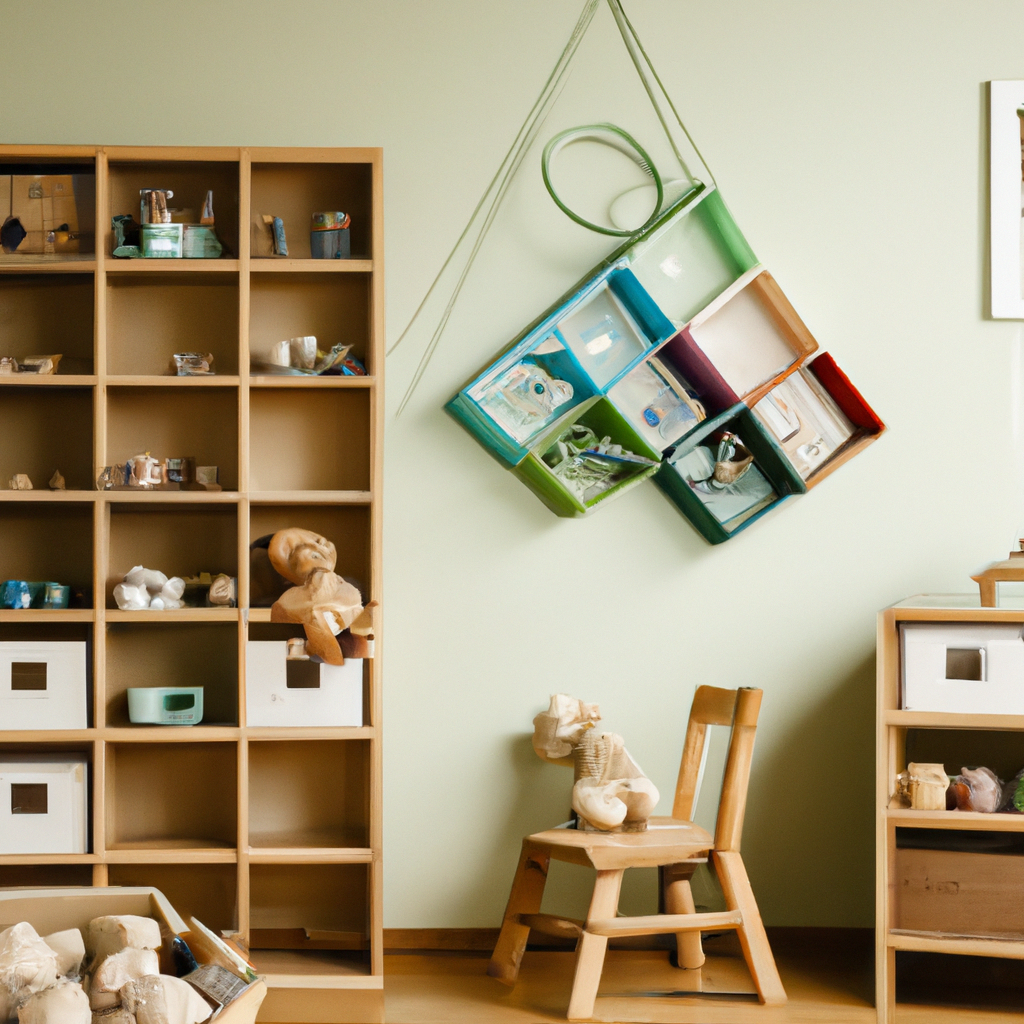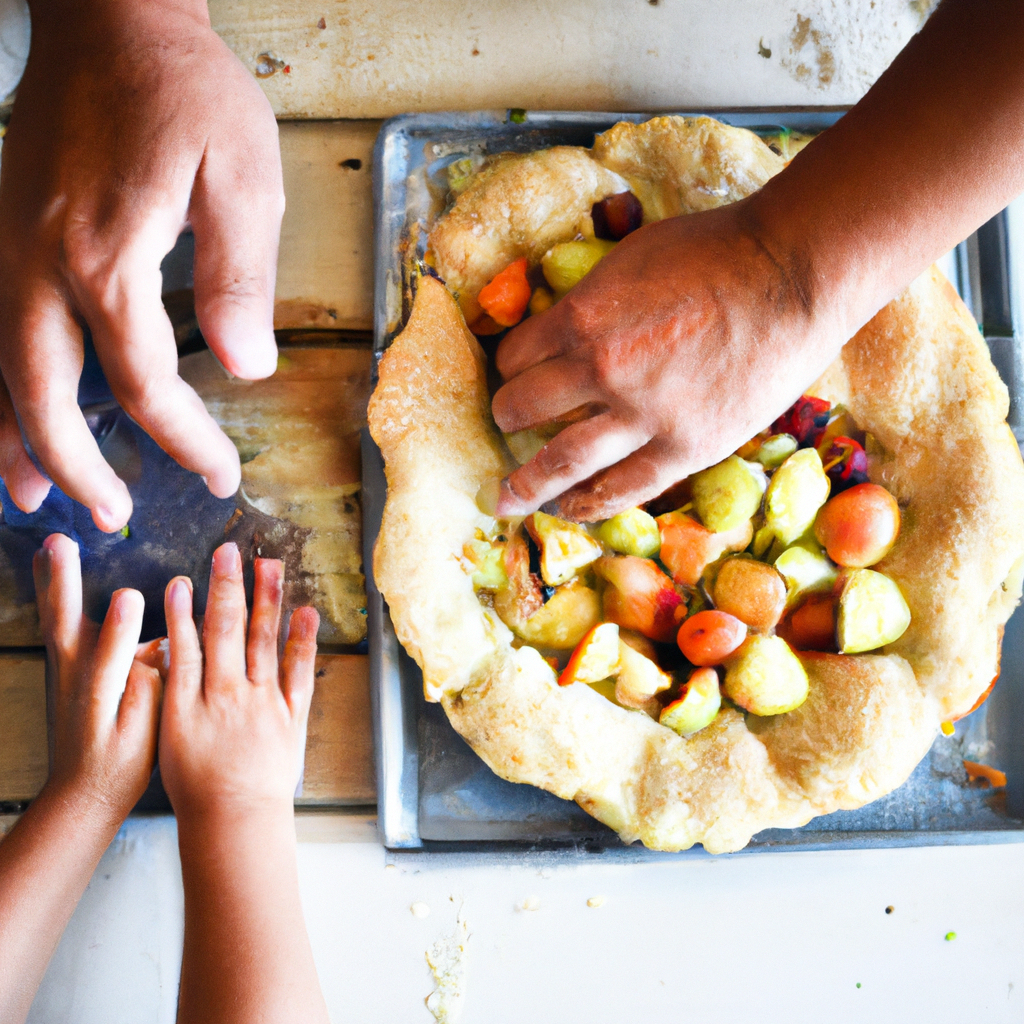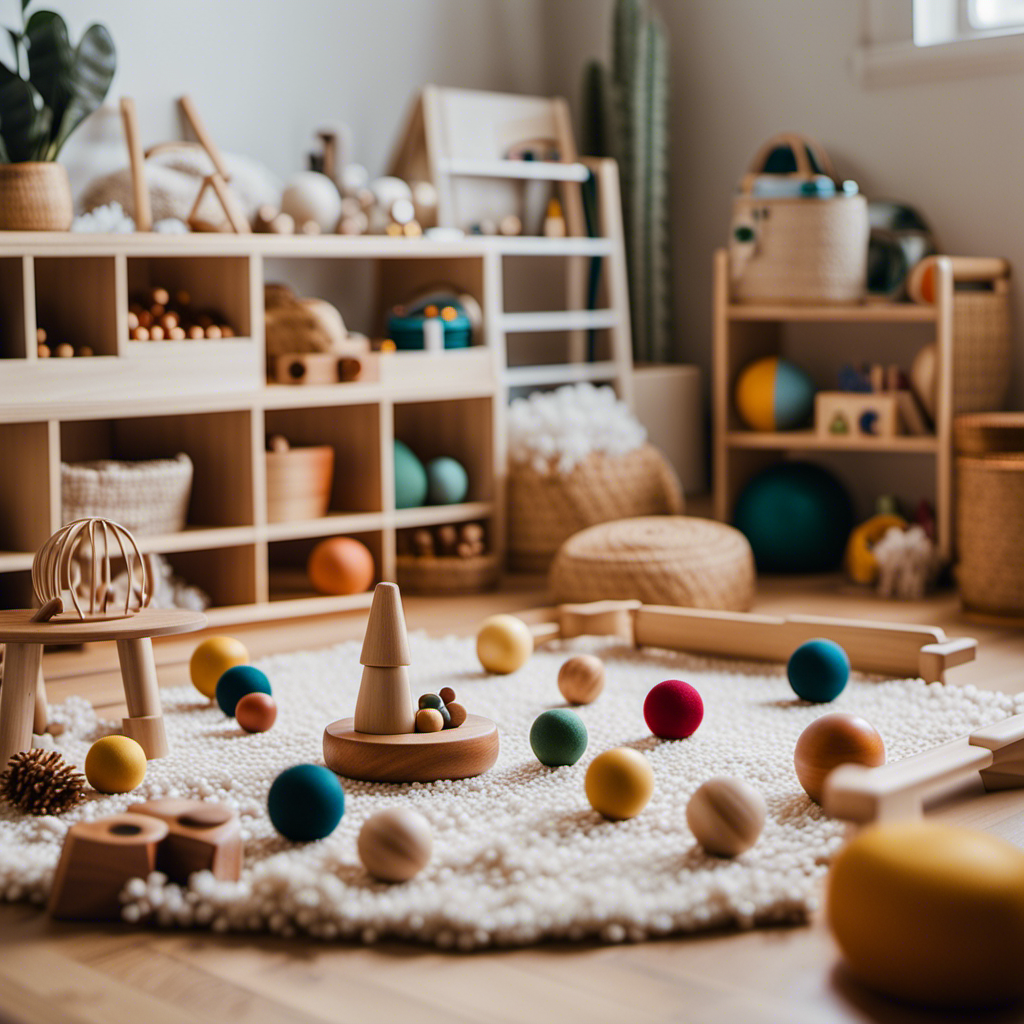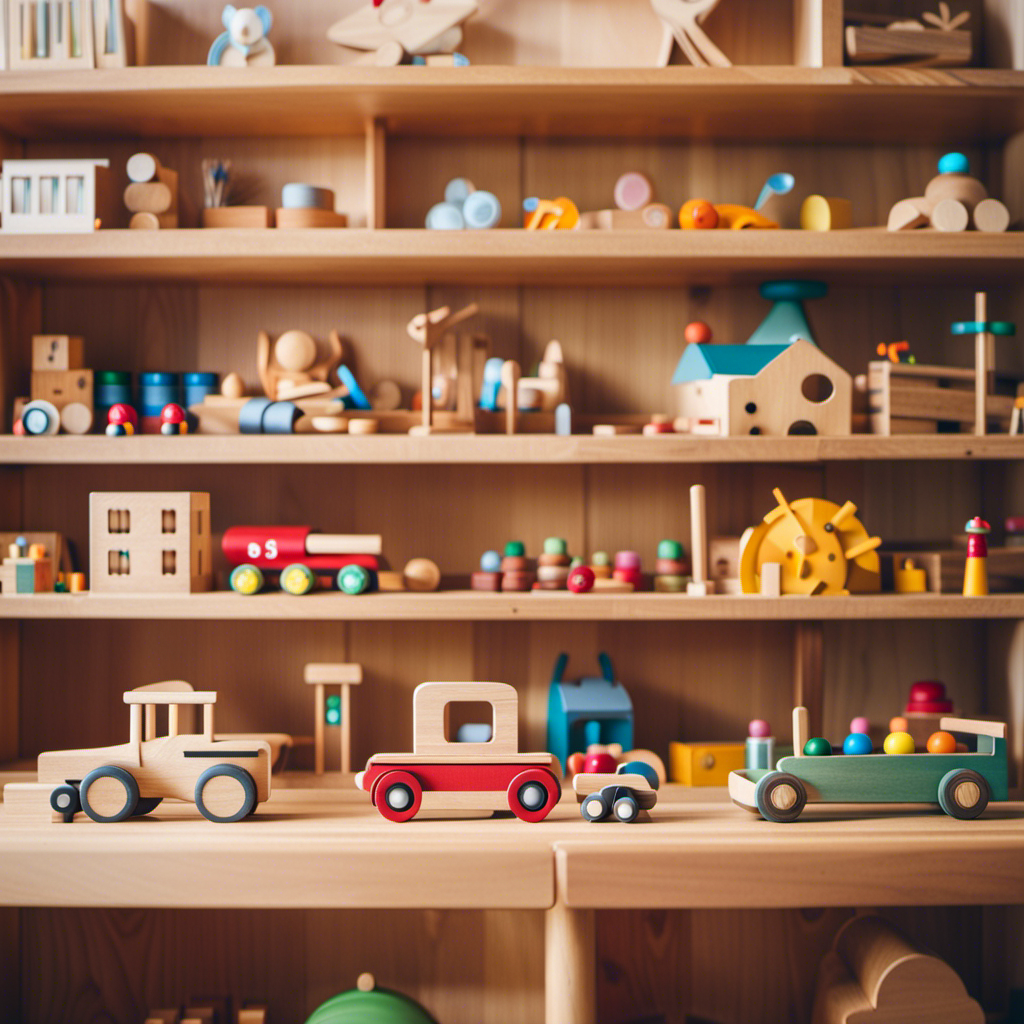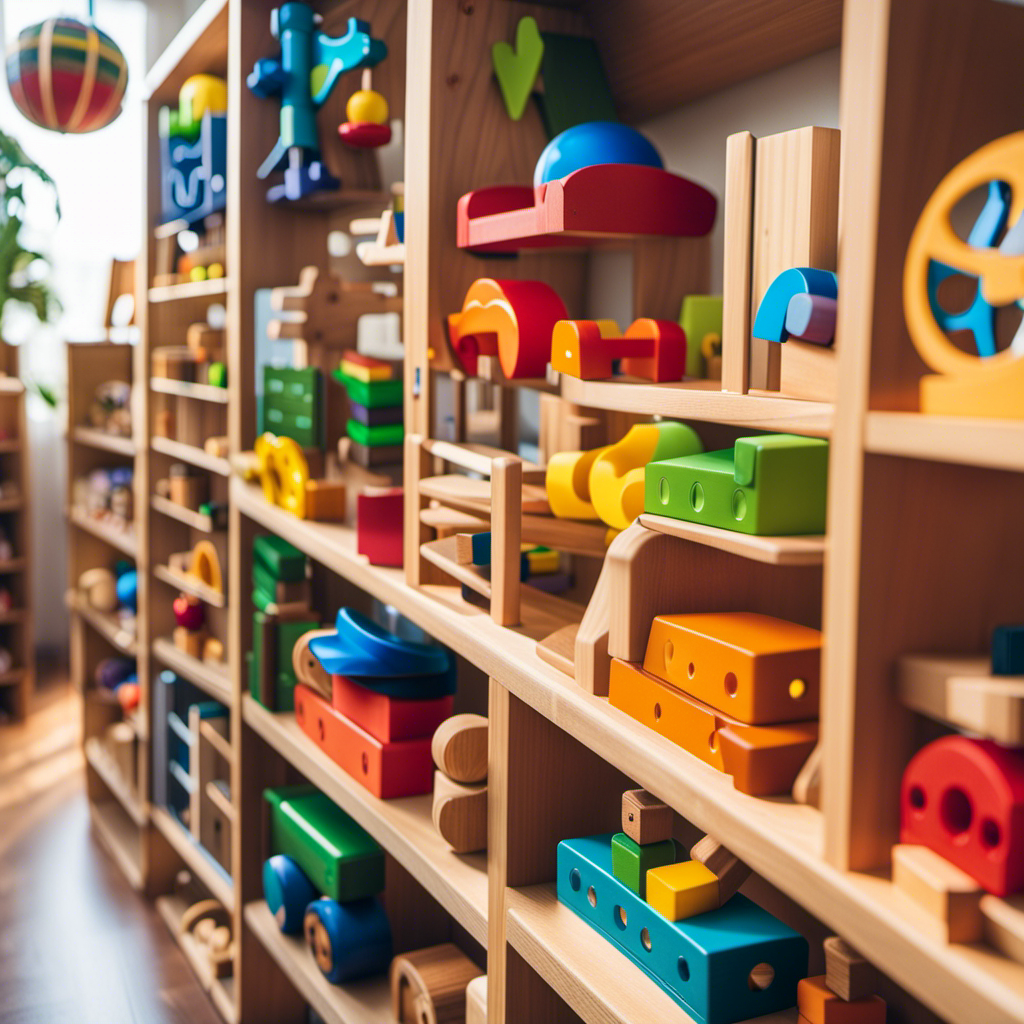As a parent, I am constantly searching for educational toys that provide more than just a temporary fad. That’s why I was intrigued by the Montessori toys philosophy.
These toys are not just about keeping kids entertained, but they are designed to promote independence, self-confidence, and cognitive development.
In this article, we will explore the principles of the Montessori approach to learning and delve into the importance of open-ended toys in this philosophy.
Get ready to discover the long-term benefits of Montessori toys for your child’s overall development.
Key Takeaways
- Montessori approach to learning is child-centered and tailored to individual needs and interests
- Montessori toys enhance creativity, problem-solving skills, and independent thinking
- Hands-on activities are important in Montessori education as they engage the senses and foster curiosity
- Open-ended toys in Montessori philosophy foster creativity, imagination, and deeper understanding of the world
Understanding the Montessori Approach to Learning
To understand the Montessori approach to learning, you’ll need to delve into its core principles and methods.
At the heart of the Montessori approach is the belief in child-centered learning. This means that the education process is tailored to the individual needs and interests of each child. Rather than following a rigid curriculum, Montessori educators encourage children to explore and discover knowledge at their own pace. This approach recognizes that every child is unique and has different strengths and learning styles.
Montessori classrooms are carefully designed to provide a prepared environment where children can engage in hands-on activities and develop their independence and problem-solving skills. By fostering a love for learning and allowing children to take ownership of their education, the Montessori approach empowers children to become lifelong learners.
Now, let’s explore the principles of Montessori education.
The Principles of Montessori Education
When it comes to education, I believe in a child-centered learning approach where the focus is on the individual needs and interests of each student.
In this approach, self-directed exploration is encouraged, allowing children to take charge of their own learning and discover their passions.
Additionally, there is an emphasis on hands-on activities, which promotes active engagement and deeper understanding of concepts.
Child-Centered Learning Approach
The child-centered learning approach in Montessori toys emphasizes hands-on exploration and self-directed discovery. This approach focuses on individualized learning, allowing children to develop at their own pace and follow their own interests. Montessori toys are designed to promote independent thinking, problem-solving skills, and creativity. They encourage children to explore and discover the world around them through interactive play. By providing a wide range of materials and activities, Montessori toys help children develop their cognitive, physical, and social-emotional skills. They also foster a sense of autonomy and confidence, as children are encouraged to make choices and take responsibility for their own learning. This child-centered approach creates a nurturing and engaging environment where children can thrive and reach their full potential.
| Benefit | Emotion | Example Toy |
|---|---|---|
| Enhances creativity | Excitement | Art supplies, building blocks |
| Develops problem-solving | Confidence | Puzzles, brain teasers |
| Promotes independent thinking | Curiosity | Science kits, exploration tools |
| Fosters social-emotional skills | Joy | Dollhouses, pretend play sets |
| Encourages physical development | Energetic | Balance boards, climbing frames |
In Montessori toys, self-directed exploration is encouraged. Children are given the freedom to choose their activities and explore their interests. This approach promotes a sense of ownership and motivation in children, as they have control over their own learning. By allowing children to take the lead, Montessori toys foster a love for learning and a sense of empowerment. This self-directed exploration helps children develop important skills such as problem-solving, critical thinking, and decision-making. It also encourages independence and self-confidence, as children learn to trust their own abilities and take initiative in their learning journey.
Self-Directed Exploration Encouraged
Explore your interests and choose activities that you’re passionate about to foster self-directed exploration. Child-led learning is a key aspect of promoting independent exploration in children. Allowing children to take the lead in their learning enables them to follow their own interests and curiosity, leading to a deeper understanding of the world around them. This approach encourages children to ask questions, seek answers, and actively engage in their own learning process.
Research has shown that self-directed exploration enhances critical thinking skills, problem-solving abilities, and creativity. It also promotes a sense of autonomy and self-confidence in children. By empowering children to take ownership of their learning, we’re setting them up for success in both their academic and personal lives.
Now, let’s transition into the next section about the emphasis on hands-on activities. It becomes evident that providing children with opportunities for hands-on learning experiences further enhances their self-directed exploration.
Emphasis on Hands-On Activities
Get ready to engage in hands-on activities that will enhance your self-directed exploration.
In Montessori education, there is a strong emphasis on incorporating sensory exploration and hands-on learning into the curriculum. These activities allow children to actively participate in their own learning process and develop a deeper understanding of the concepts being taught.
By using their senses to explore and manipulate materials, children can make connections and engage in meaningful experiences. For example, they may use their hands to feel different textures or their eyes to observe the colors and patterns of objects.
Through these hands-on activities, children are able to actively engage with the world around them, fostering their curiosity and promoting a love for learning.
As we delve deeper into the importance of open-ended toys in Montessori philosophy, we will discover how these materials further support children’s exploration and creativity.
The Importance of Open-Ended Toys in Montessori Philosophy
When it comes to fostering creativity through play, open-ended toys play a crucial role in the Montessori philosophy.
These toys allow children to explore their imagination and come up with unique ways to use them.
By providing children with the freedom to create and explore independently, they are encouraged to develop their own ideas and think outside the box.
Ultimately, this approach not only enhances their creativity but also fosters independence and a sense of exploration in their learning journey.
Enhancing Creativity Through Play
Playing with Montessori toys can boost creativity in children by encouraging open-ended exploration and imaginative thinking. Open-ended play allows children to use their creativity and problem-solving skills as they explore different possibilities and create their own narratives.
Montessori toys, such as building blocks or sensory materials, provide a blank canvas for children to use their imagination and think outside the box. By fostering imagination, these toys allow children to develop their storytelling abilities, enhance their cognitive skills, and acquire a deeper understanding of the world around them.
As children engage in open-ended play, they learn to think independently, make decisions, and explore their surroundings with curiosity. This sense of independence and exploration sets the stage for the subsequent section on fostering independence and exploration, where children can further develop their skills and grow as individuals.
Fostering Independence and Exploration
As you explore and engage in open-ended activities, you’ll discover new ways to foster independence and encourage exploration in your child. Independent play and hands-on exploration are crucial for their development and growth. Here are four ways to promote independence and exploration:
-
Provide a safe and stimulating environment: Set up a space where your child can freely explore and play without constant supervision. This allows them to feel comfortable and confident in their own abilities.
-
Offer age-appropriate toys and materials: Choose toys that are designed to encourage independent play and exploration. Montessori toys, for example, are specifically designed to promote hands-on learning and self-discovery.
-
Encourage problem-solving and decision-making: Allow your child to make choices and solve problems on their own. This helps them develop critical thinking skills and boosts their confidence in their own abilities.
-
Foster a sense of curiosity and wonder: Encourage your child to ask questions, explore their surroundings, and engage in activities that spark their curiosity. This helps them develop a love for learning and a sense of independence.
How Montessori Toys Promote Independence and Self-Confidence
You can see how Montessori toys promote independence and self-confidence in children. These toys are specifically designed to encourage independent play and exploration, allowing children to take control of their own learning experiences. By providing opportunities for decision-making and problem-solving, Montessori toys help build self-esteem and confidence in children.
One way Montessori toys promote independence is by offering open-ended play possibilities. These toys do not have a fixed outcome or a specific set of instructions, allowing children to use their imagination and creativity to explore different ways of playing. This freedom of choice helps children develop a sense of autonomy and self-reliance.
Moreover, Montessori toys often focus on real-life activities and skills, such as practical life toys or sensorial materials. These toys mimic everyday activities and tasks, allowing children to practice and master skills in a safe and supportive environment. This hands-on approach gives children a sense of accomplishment and boosts their confidence as they successfully complete tasks.
Additionally, Montessori toys are designed to be developmentally appropriate, meaning they align with the natural abilities and interests of children at different stages of development. This ensures that children feel challenged but not overwhelmed, which can greatly enhance their self-confidence.
To summarize, Montessori toys promote independence and self-confidence in children by offering open-ended play possibilities, focusing on real-life activities and skills, and being developmentally appropriate. By engaging in independent play with these toys, children can develop a strong sense of self and build their confidence in their abilities.
With the foundation of promoting independence and self-confidence, let’s now explore how Montessori toys also impact cognitive development.
Montessori Toys and Their Impact on Cognitive Development
By engaging in independent play with Montessori toys, children can develop cognitive skills such as problem-solving and critical thinking. These toys are designed to stimulate the mind and encourage active engagement, leading to long-term cognitive benefits.
Here are four ways in which Montessori toys impact cognitive development:
-
Shape sorting puzzles: Children learn to identify and match different shapes, enhancing their spatial awareness and logical thinking.
-
Counting toys: Manipulating objects and counting them helps children develop their numerical skills and understanding of basic math concepts.
-
Building blocks: Constructing structures with blocks improves problem-solving abilities, as children learn to plan, balance, and create stable structures.
-
Memory games: Matching pairs of cards or objects enhances memory and concentration skills, while also fostering cognitive flexibility.
The Role of Sensory Experiences in Montessori Toys
As an educator, I’ve always believed in the importance of tactile learning for enhancing cognitive development in children. Research has shown that engaging in hands-on activities and exploring through touch can significantly improve their understanding and retention of information.
Furthermore, tactile learning promotes the development of fine motor skills and hand-eye coordination, which are essential for various daily tasks and future academic pursuits.
Importance of Tactile Learning
The importance of tactile learning is evident in the way Montessori toys are designed to engage multiple senses. Tactile exploration plays a crucial role in sensory development, allowing children to learn about the world through touch.
Montessori toys are carefully crafted to provide various textures, shapes, and sizes that stimulate the sense of touch. By encouraging children to physically manipulate objects, these toys promote sensory integration and fine motor skills.
When children engage in tactile exploration, they develop a deeper understanding of materials and their properties. This hands-on approach enhances their ability to discriminate between different textures, temperatures, and weights.
Additionally, tactile learning promotes the development of neural connections in the brain, leading to enhanced cognitive development. As children explore the textures and shapes of Montessori toys, they are also building the foundation for future learning and problem-solving skills.
Enhancing Cognitive Development
Engaging in tactile exploration through the use of Montessori toys helps children develop cognitive skills. Early learning is a crucial stage in a child’s life, and providing them with opportunities to engage with their environment through sensory experiences is essential for their cognitive growth.
Montessori toys are designed to stimulate different senses, encouraging children to explore, manipulate, and problem-solve. These toys promote cognitive development by enhancing skills such as memory, attention, and problem-solving abilities. Research has shown that children who engage in tactile exploration through Montessori toys demonstrate improved cognitive abilities compared to those who do not.
Through hands-on experiences, children develop their cognitive skills, enabling them to understand and navigate the world around them more effectively. Transitioning into the subsequent section about Montessori toys and the development of fine motor skills, these toys also play a significant role in enhancing a child’s physical abilities.
Montessori Toys and the Development of Fine Motor Skills
Improve your child’s fine motor skills with Montessori toys. These toys are designed to promote fine motor development and encourage sensory exploration. Here are some key benefits of Montessori toys for fine motor skills:
-
Enhance hand-eye coordination: Montessori toys often require precise movements, such as stacking blocks or fitting shapes into corresponding holes. These activities help develop hand-eye coordination and improve dexterity.
-
Develop finger strength and control: Activities like using tweezers to pick up objects or manipulating small buttons on a dressing board help strengthen the muscles in the fingers and promote fine motor control.
-
Encourage concentration and focus: Montessori toys are designed to engage children’s attention and promote concentration. This focus on the task at hand helps develop their ability to concentrate for extended periods.
-
Foster problem-solving skills: Montessori toys often involve problem-solving elements, such as puzzles or building sets. These activities encourage children to think critically and find solutions, promoting cognitive development alongside fine motor skills.
By incorporating Montessori toys into your child’s playtime, you can support their fine motor development while also providing a fun and engaging learning experience.
Next, let’s explore the benefits of Montessori toys for language and communication development.
The Benefits of Montessori Toys for Language and Communication
Let’s explore how Montessori toys can benefit your child’s language and communication skills.
Montessori toys are specifically designed to promote language development and enhance communication skills in children. These toys encourage children to engage in imaginative play, which helps them develop their vocabulary, sentence structure, and storytelling abilities.
For example, wooden blocks with letters or pictures on them can assist children in learning new words and forming sentences. Montessori toys also provide opportunities for children to practice their listening and speaking skills through activities such as storytelling or playing with puppets.
Research has shown that children who engage with Montessori toys have better language and communication skills compared to those who do not.
As we delve into the next section about Montessori toys and social-emotional development, we will see how these toys can foster emotional intelligence and empathy in children.
Montessori Toys and Social-Emotional Development
Montessori toys can help children develop emotional intelligence and empathy. These toys are designed to promote social skills and emotional well-being, allowing children to learn and practice important social-emotional skills through play. By engaging with Montessori toys, children can learn to recognize and understand their own emotions, as well as the emotions of others. This fosters empathy and the ability to communicate effectively with others.
To highlight the impact of Montessori toys on social-emotional development, consider the following table:
| Social Skills | Emotional Intelligence |
|---|---|
| Cooperation | Self-awareness |
| Empathy | Emotional regulation |
| Communication | Social problem-solving |
As children engage with Montessori toys, they naturally develop these social skills and emotional intelligence, which are essential for building positive relationships and navigating social situations. This sets a strong foundation for their future interactions and overall well-being.
Transition: In addition to promoting social-emotional development, the connection between Montessori toys and problem-solving skills is another important aspect to consider.
The Connection Between Montessori Toys and Problem-Solving Skills
When children engage with Montessori toys, they are not only developing social-emotional skills, but also honing their problem-solving abilities and critical thinking skills. Montessori toys are designed to encourage exploration and independent thinking, fostering the development of problem-solving strategies.
Here are five ways in which Montessori toys support problem-solving skills:
- Montessori toys promote hands-on exploration, allowing children to actively engage with their environment.
- These toys encourage trial and error, teaching children the importance of perseverance and resilience in problem-solving.
- Montessori toys often have open-ended designs, allowing children to come up with multiple solutions to a given problem.
- These toys stimulate creativity and imagination, enabling children to think outside the box when faced with challenges.
- Montessori toys encourage logical thinking and reasoning, helping children develop analytical skills.
By providing children with opportunities to develop problem-solving skills through Montessori toys, parents can support their overall cognitive development.
In the next section, we will explore how to incorporate Montessori toys into the home environment seamlessly.
Incorporating Montessori Toys Into the Home Environment
To seamlessly incorporate Montessori toys into your home environment, consider creating designated play areas that are easily accessible and organized. By creating a Montessori-inspired play space, you can foster independence, creativity, and cognitive development in your child.
Start by selecting toys that align with the Montessori philosophy, such as open-ended materials that encourage exploration and problem-solving. Next, organize the toys in a way that allows your child to easily see and access them. Consider using low shelves or baskets to display the toys, allowing your child to choose what they want to play with.
Additionally, implementing a toy rotation system can help keep the play space fresh and engaging. This involves periodically swapping out toys to maintain your child’s interest and prevent overwhelm.
By creating a well-organized and thoughtfully designed play area, you can support your child’s learning and development.
Transition: Now that we have discussed how to incorporate Montessori toys into your home environment, let’s explore the long-term benefits of these toys for children’s overall development.
The Long-Term Benefits of Montessori Toys for Children’s Overall Development
You’ll be amazed at how Montessori toys can positively impact your child’s overall development, fostering skills such as problem-solving, independence, and creativity.
But the benefits of Montessori toys go beyond just immediate skill development. They have long-lasting effects on a child’s holistic development. Research shows that children who engage with Montessori toys from a young age develop a strong foundation for learning and growth.
These toys promote independent thinking, as children are encouraged to explore and discover on their own. This fosters a sense of autonomy and self-confidence, which are essential for a child’s overall development.
Additionally, Montessori toys are designed to stimulate multiple senses and encourage hands-on learning, promoting cognitive, physical, and emotional development.
The holistic approach of Montessori toys ensures that your child is not only learning valuable skills but also developing into a well-rounded individual.
Frequently Asked Questions
Are Montessori Toys Only Suitable for Children Who Attend Montessori Schools?
Montessori toys are not exclusive to children attending Montessori schools. They promote inclusivity by focusing on individualized learning and self-directed play. The benefits of Montessori toys extend to all children, fostering independence, creativity, and cognitive development.
How Do Montessori Toys Differ From Traditional Toys?
Montessori toys differ from traditional toys in that they promote independent learning and critical thinking. Their benefits lie in their educational approach, which focuses on hands-on learning, self-directed exploration, and fostering a child’s natural curiosity.
Can Montessori Toys Be Used for Children With Special Needs?
Yes, Montessori toys can be used for children with special needs. They promote inclusion and provide various benefits such as promoting independence, improving fine motor skills, and enhancing cognitive development.
Are There Any Safety Concerns With Montessori Toys?
There are no safety concerns with Montessori toys as they adhere to strict safety standards. In fact, these toys not only promote child development but also provide a safe and engaging learning environment.
What Age Range Are Montessori Toys Designed For?
Montessori toys are designed for children in the age range of 0-6 years old. These toys are carefully crafted to promote developmental benefits such as fine motor skills, cognitive development, and sensory exploration.
Conclusion
In conclusion, Montessori toys offer a world of possibilities for children’s development. These toys, with their open-ended nature and focus on independence, foster a sense of self-confidence and autonomy in children.
Through play, children are able to develop their cognitive and social-emotional skills, while also honing their problem-solving abilities.
By incorporating Montessori toys into the home environment, parents can provide their children with a foundation for lifelong learning and growth. The long-term benefits of these toys extend far beyond the trend, nurturing children’s overall development in a gentle and effective way.
Mila, a gifted writer with a heart brimming with enthusiasm for child development and playful learning, is the creative force behind the enchanting narratives and insightful articles that grace Toddler Ride On Toys. With a background in early childhood education and a genuine passion for nurturing young minds, Mila weaves words that captivate, educate, and inspire parents, caregivers, and educators.
